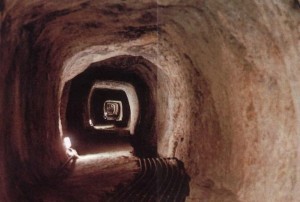The Tunnel of Eupalinos, one of the most extraordinary monuments of craftmanship and construction (1,036 metres carved inside the mountain that towers over the town of Pythagorio on Samos) will be very soon accessible.
The Culture Ministry announced that the main part of the maintenance, restoration and promotion project of the Eupaline Tunnel that was approved by the Ministry, namely the tunnel in which were the clay water pipes. “The acquaintance with the Eupaline Tunnel is a life experience,” said Culture Minister Lydia Koniordou.
The Eupalinian aqueduct was designed and built in 550 BC by the engineer Eupalinos from Megara when Samos was ruled by tyrant Polycrates. It continued to supply the ancient town of Pythagorio with fresh water for 1,100 years. Eupalinos used what are now well-known principles of geometry, which were codified by Euclid several centuries later. With a length of 1,036 metres (3,399 ft), the Eupalinian subterranean aqueduct is famous today as one of the masterpieces of ancient engineering. Eupalinos used mathematics and geometry not only to align the excavations before they met, but also to “manipulate” the alignment of the tunnel in order to avoid adverse geological conditions. Mutatis mutandis, the basic principle behind the method of Eupalinos, has been used again long after the Renaissance of Europe (early 18th century), and it is still in use in modern tunnelling.
The Eupalinian aqueduct or ditch, is cited by Herodotus (Histories 3.60), without whom it would not have been discovered:
“And about the Samians I have spoken at greater length, because they have three works which are greater than any others that have been made by Hellenes: first a passage beginning from below and open at both ends, dug through a mountain not less than a hundred and fifty orguia in height; the length of the passage is seven stadia and the height and breadth each eight feet, and throughout the whole of it another passage has been dug twenty cubits in depth and three feet in breadth, through which the water is conducted and comes by the pipes to the city, brought from an abundant spring: and the designer of this work was a Megarian, Eupalinos the son of Naustrophos”.
In 1992, the Eupalinian ditch was included in UNESCO’s world cultural heritage list.
Ask me anything
Explore related questions







